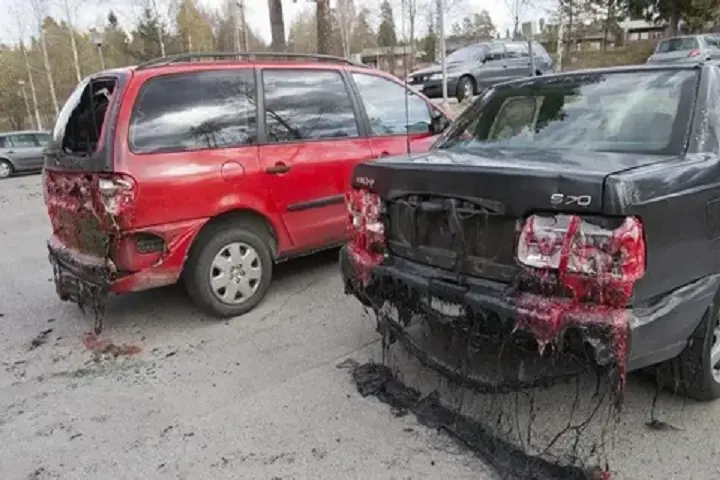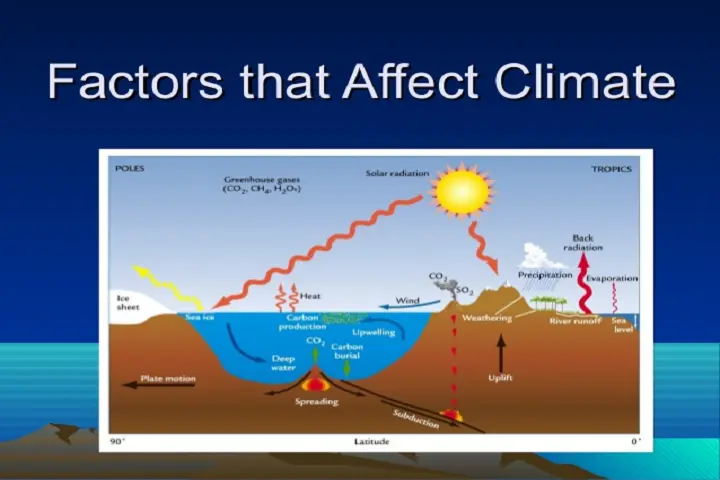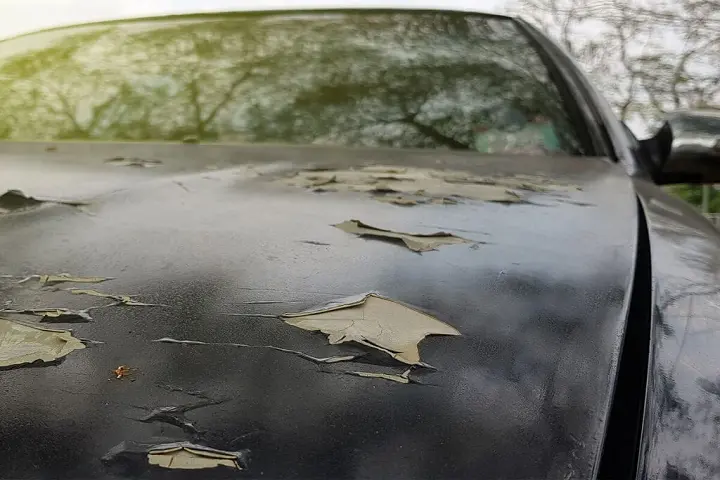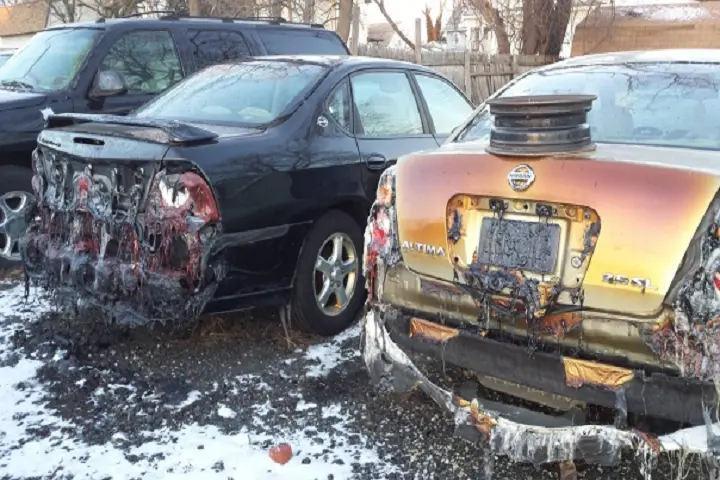In a world where climate change is pushing temperatures to new extremes, our vehicles are facing unprecedented challenges.
From melting dashboards to warping bumpers, the impact of extreme heat on our cars is becoming a pressing concern.
But can scorching temperatures actually turn your prized automobile into a puddle of metal and plastic? Let’s dive into the sizzling world of Melt Car Parts and discover how to keep your ride cool when the mercury soars.
The Science Behind Heat and Car Materials
To understand how high temperatures impact cars, we need to get under the hood of material science. Different parts of your vehicle react uniquely to heat, and knowing these reactions can help you protect your car during heatwaves.
Melting Points: Not All Materials Are Created Equal
Here’s a quick rundown of common car materials and their melting points:
| Material | Melting Point (°C) | Common Car Parts |
| Steel | 1370-1530 | Body panels, frame |
| Aluminum | 660 | Engine blocks, wheels |
| Plastic | 100-465 (varies) | Dashboard, trim, bumpers |
| Rubber | 180 | Tires, seals, hoses |
While it’s unlikely your entire car will turn into a molten mess, certain components are at risk during extreme heat events.
How Heat Affects Different Parts
- Plastic components: Most vulnerable to warping and melting. Dashboard surfaces can become sticky or even bubble in intense heat.
- Rubber parts: May soften and degrade, leading to cracks in hoses or tire blowouts.
- Metal elements: While they won’t melt in typical heatwaves, prolonged exposure can cause expansion and potential misalignment.
“The materials used in modern vehicles are designed to withstand a wide range of temperatures, but extreme conditions can push them to their limits,” says Dr. Sarah Chen, automotive materials expert at MIT.
Real-Life Car-Melting Incidents

The “Fryscraper” Fiasco: Walkie-Talkie Skyscraper Jaguar Damage
In 2013, London’s skyline became home to an unexpected hazard. The concave design of the 20 Fenchurch Street building, nicknamed the “Walkie-Talkie,” created a solar death ray that focused sunlight onto the street below. The result? A partially melted Jaguar XJ.
- The car’s side mirror and badge melted
- Panels warped from the intense heat
- Estimated repair cost: £946
This incident highlighted how reflective surfaces can amplify the sun’s power, turning an ordinary street into a makeshift oven.
Italian Heatwave vs. Renault Megane
During a blistering heatwave in Italy, social media lit up with images of a Renault Megane melting in the sun. The car’s plastic bumper and lights appeared to be dripping onto the pavement, creating a surreal scene.
Key factors contributing to the meltdown:
- Temperatures exceeding 37°C (98.6°F)
- Dark color of the car absorbing more heat
- Prolonged exposure to direct sunlight
Other Documented Cases Worldwide
- Arizona, USA: Multiple reports of melting dashboards and steering wheels
- Kuwait: A viral video showed a car’s taillight melting in 52°C (125.6°F) heat
- Australia: Numerous incidents of warped plastic trim during record-breaking heatwaves
Most Vulnerable Car Parts in Extreme Heat
When temperatures skyrocket, certain parts of your vehicle are more susceptible to damage. Let’s break down the hot spots:
Exterior Components
- Trim and moldings: Often made of plastic or rubber, these can warp or come loose.
- Bumpers: Modern plastic bumpers can soften and deform in extreme heat.
- Side mirrors: As seen in the London incident, these can melt or warp.
Tires and Wheel Wells
- Tire pressure: Heat causes air to expand, potentially leading to overinflation.
- Rubber degradation: Prolonged heat exposure can cause cracking and reduce tire lifespan.
Interior Dashboard and Upholstery
The dashboard is particularly vulnerable to heat damage:
- Sticky or tacky surfaces
- Bubbling or warping of plastic components
- Fading or cracking of leather seats
Under-the-Hood Components
While these parts are designed to handle heat, extreme temperatures can still cause issues:
- Battery: Heat accelerates chemical reactions, potentially shortening battery life.
- Fluids: Engine oil and coolant can break down faster in high heat.
- Belts and hoses: Rubber components may crack or deteriorate more quickly.
Factors That Amplify Heat Damage

Several elements can turn up the heat on your car, increasing the risk of damage:
Car Color and Heat Absorption
It’s not just a matter of style – your car’s color can significantly affect its heat retention:
| Color | Heat Absorption |
| Black | Highest |
| Dark Blue | High |
| Red | Medium-High |
| White | Lowest |
Parking Location: Sun vs. Shade
Where you park can make a world of difference:
- Direct sunlight: Can increase interior temperatures by up to 40°C (104°F) above ambient temperature.
- Shaded areas: Can keep your car up to 11°C (20°F) cooler than parking in the sun.
Reflective Surfaces Nearby
Urban environments can create heat traps:
- Glass buildings can reflect and concentrate sunlight (remember the “Fryscraper”?)
- Asphalt parking lots absorb and radiate heat, creating a mini heat island effect
Preventing Heat-Related Car Damage
Protecting your vehicle from the sun’s wrath doesn’t have to be complicated. Here are some effective strategies:
Protective Measures
- Car covers: A reflective cover can significantly reduce heat absorption.
- Window tints: Can block up to 99% of UV rays, keeping the interior cooler.
- Windshield sunshades: An inexpensive way to reduce dashboard temperatures.
Strategic Parking Tips
- Seek shade: Park under trees or in covered structures whenever possible.
- Face east: If parking outside all day, facing east means the sun will move over the car’s roof instead of through the windshield.
- Use natural barriers: Park next to large buildings to take advantage of their shadow.
Regular Maintenance for Heat Resistance
- Keep fluids topped up, especially coolant
- Check tire pressure regularly, adjusting for temperature changes
- Apply UV-protective treatments to plastic and rubber components
When Heat Cracks More Than Paint

Windscreen Shattering and Window Vulnerabilities
Extreme heat can wreak havoc on your car’s glass components:
- Rapid temperature changes can cause windscreen chips and cracks to expand
- Existing damage is more likely to spread in high heat
- In rare cases, severe temperature differentials can cause windshields to shatter
How Extreme Temperatures Affect Auto Glass
Auto glass is designed to withstand a range of temperatures, but it’s not invincible:
- Heat causes glass to expand
- If there’s a weak point (like a chip), the expansion can cause it to fail
- Repeated heating and cooling cycles can weaken glass over time
Prevention and Quick Fixes
To avoid a shattered windshield:
- Repair chips and cracks promptly
- Avoid sudden temperature changes (like blasting cold AC on a hot windshield)
- Use a sunshade to keep your car’s interior temperature more stable
If you notice a new crack, have it assessed by a professional immediately. Many small cracks can be repaired before they become a bigger problem.
Climate Change and Future Car Design
As global temperatures continue to rise, the automotive industry is adapting to meet new challenges.
Rising Global Temperatures and Automotive Challenges
- More frequent and intense heatwaves are pushing cars to their limits
- Manufacturers are reevaluating traditional materials and designs
- Durability in extreme conditions is becoming a key selling point
Innovations in Heat-Resistant Materials
Researchers and engineers are developing new materials to withstand higher temperatures:
- Nano-coatings that reflect more sunlight
- Advanced polymers with higher melting points
- Carbon fiber composites that maintain strength at high temperatures
Adaptive Designs for Extreme Weather
Future cars may include features like:
- Adaptive cooling systems that respond to external temperatures
- Self-tinting windows that darken in bright sunlight
- “Smart” paint that changes color to reflect more heat in summer
What to Do If Your Car Shows Heat Damage
If you suspect your car has been affected by extreme heat, take these steps:
Immediate Actions
- Document the damage with photos
- Move the car to a cooler location if possible
- Allow the vehicle to cool down before attempting to drive
When to Call a Professional
Seek expert help if you notice:
- Warped exterior panels or trim
- Cracked or bubbling dashboard
- Unusual smells or smoke
- Performance issues after exposure to heat
Insurance Considerations
- Check your policy for coverage related to weather damage
- Some insurers may cover heat-related damage under comprehensive policies
- Document all damage and repairs for potential claims
Keeping Your Cool When Your Car Can’t

As we’ve seen, extreme heat can indeed cause significant damage to our vehicles, from melting plastic in cars to potentially dangerous situations like windscreen shattering. While it’s unlikely that your entire car will melt away like the infamous Renault Megane melting incident, the risks of heat damage are real and growing.
By understanding the vulnerabilities of different car parts and taking proactive measures, you can protect your vehicle from the worst effects of heatwaves. Remember:
- Park smart: Shade is your friend
- Use protective accessories like sunshades and car covers
- Stay on top of maintenance, especially during summer months
- Be aware of your car’s condition and address any issues promptly
As our climate continues to change, so too will our approach to vehicle care and design. Stay informed, stay prepared, and keep your cool even when the temperature’s not.
FAQs
Q: Can extreme heat affect my car’s performance?
A: Yes, extreme heat can impact various aspects of your car’s performance, including reduced engine efficiency, increased risk of overheating, and potential battery issues.
Q: Are certain car brands more heat-resistant than others?
A: While all modern cars are designed to withstand a range of temperatures, some luxury and high-performance brands may use more advanced heat-resistant materials. However, proper maintenance is crucial regardless of the brand.
Q: How hot does it need to be for car parts to melt?
A: It depends on the material. Plastic components can begin to soften around 100°C (212°F), while most metals used in cars have much higher melting points. However, damage can occur at lower temperatures with prolonged exposure.
Q: Can heat damage void my car warranty?
A: Generally, warranties don’t cover damage from natural events like extreme heat. However, if heat-related damage is due to a manufacturing defect, it might be covered. Always check your specific warranty terms.
Q: What’s the difference between car wax and ceramic coating for heat protection?
A: Car wax provides a temporary protective layer that can offer some heat reflection, while ceramic coating creates a more durable, longer-lasting barrier that’s more effective at protecting against heat and UV rays.
Conclusion: Melt Car Parts
In conclusion, while extreme heat can indeed wreak havoc on your car, total meltdown is rare. However, the risks of warped plastics, cracked windshields and overheating engines are real and increasing with climate change.
By understanding your vehicle’s vulnerabilities and taking proactive steps like strategic parking, using protective accessories, and maintaining your car regularly you can shield your ride from the worst of the heat.
As automotive technology evolves to meet these challenges, staying informed about new materials and designs will help you make smarter choices.
Remember, a little prevention goes a long way in keeping your car cool when temperatures soar. Stay vigilant, stay prepared, and keep your cool on the road.

With over 5 years of dedicated experience in the automotive industry, I am passionate about all things automotive. My journey began with a deep curiosity for automobiles, which led me to delve deeper into their mechanics, technology and trends. My expertise spans various aspects of the automotive world, from the latest electric vehicles to classic car restoration techniques. Through my articles, I aim to share my knowledge and insights, helping readers stay informed and inspired in the fast-paced world of the automobile.











